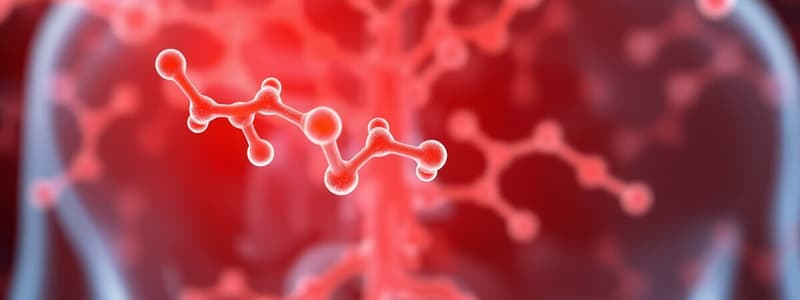Podcast
Questions and Answers
Which structure in the central nervous system is primarily responsible for the secretion of endorphins during stress?
Which structure in the central nervous system is primarily responsible for the secretion of endorphins during stress?
What is the role of enkephalin in the pain inhibitory complex?
What is the role of enkephalin in the pain inhibitory complex?
Which of the following opioid peptides is secreted by the raphe magnus nucleus?
Which of the following opioid peptides is secreted by the raphe magnus nucleus?
What type of pain do Aδ fibers primarily carry?
What type of pain do Aδ fibers primarily carry?
Signup and view all the answers
Which system in the CNS is involved in controlling pain at higher levels?
Which system in the CNS is involved in controlling pain at higher levels?
Signup and view all the answers
Where is the pain inhibitory complex located in the spinal cord?
Where is the pain inhibitory complex located in the spinal cord?
Signup and view all the answers
Which type of therapy would likely involve the activation of the analgesia system through emotional stimuli?
Which type of therapy would likely involve the activation of the analgesia system through emotional stimuli?
Signup and view all the answers
The presence of which receptors is crucial in the pain control mechanisms discussed?
The presence of which receptors is crucial in the pain control mechanisms discussed?
Signup and view all the answers
Which sensory modalities are typically lost in Syringomyelia due to damage to the lateral spinothalamic tracts?
Which sensory modalities are typically lost in Syringomyelia due to damage to the lateral spinothalamic tracts?
Signup and view all the answers
What is a characteristic gait associated with sensory ataxia due to Tabes Dorsalis?
What is a characteristic gait associated with sensory ataxia due to Tabes Dorsalis?
Signup and view all the answers
In Tabes Dorsalis, which sensory tracts primarily degenerate, leading to loss of fine touch and vibration sense?
In Tabes Dorsalis, which sensory tracts primarily degenerate, leading to loss of fine touch and vibration sense?
Signup and view all the answers
What symptom is associated with loss of proprioceptive sensations in Tabes Dorsalis?
What symptom is associated with loss of proprioceptive sensations in Tabes Dorsalis?
Signup and view all the answers
Which reflexes are preserved in the early stages of Tabes Dorsalis before significant damage occurs?
Which reflexes are preserved in the early stages of Tabes Dorsalis before significant damage occurs?
Signup and view all the answers
What pattern of sensory loss characterizes a Syringomyelia lesion located in the lower cervical and upper thoracic segments?
What pattern of sensory loss characterizes a Syringomyelia lesion located in the lower cervical and upper thoracic segments?
Signup and view all the answers
Which type of fiber is primarily responsible for slow pain perception and remains intact for long periods in Tabes Dorsalis?
Which type of fiber is primarily responsible for slow pain perception and remains intact for long periods in Tabes Dorsalis?
Signup and view all the answers
Which of the following is NOT a manifestation of Syringomyelia?
Which of the following is NOT a manifestation of Syringomyelia?
Signup and view all the answers
What is the main mechanism involved in primary hyperalgesia?
What is the main mechanism involved in primary hyperalgesia?
Signup and view all the answers
In the context of pain transmission, what role do A beta fibers play?
In the context of pain transmission, what role do A beta fibers play?
Signup and view all the answers
What is the defining feature of secondary hyperalgesia?
What is the defining feature of secondary hyperalgesia?
Signup and view all the answers
Which of the following accurately describes syringomyelia?
Which of the following accurately describes syringomyelia?
Signup and view all the answers
Which substance is NOT involved in the sensitization of pain receptors in primary hyperalgesia?
Which substance is NOT involved in the sensitization of pain receptors in primary hyperalgesia?
Signup and view all the answers
What is a primary mechanism through which A delta fibers inhibit pain transmission?
What is a primary mechanism through which A delta fibers inhibit pain transmission?
Signup and view all the answers
Which statement about cutaneous hyperalgesia is true?
Which statement about cutaneous hyperalgesia is true?
Signup and view all the answers
How do impulses from areas of primary and secondary hyperalgesia interact in the spinal cord?
How do impulses from areas of primary and secondary hyperalgesia interact in the spinal cord?
Signup and view all the answers
Flashcards
Spinothalamic Tract Damage
Spinothalamic Tract Damage
Damage to the spinothalamic tracts results in loss of pain, temperature, and crude touch sensation on the affected side of the body.
Dorsal Column Damage
Dorsal Column Damage
Damage to the dorsal columns affects sensations like fine touch, vibration, and proprioception (sense of body position).
Sensory Ataxia
Sensory Ataxia
A condition characterized by uncoordinated movements due to loss of proprioceptive sensation (body position sense).
Tabes Dorsalis
Tabes Dorsalis
Signup and view all the flashcards
Romberg's Sign
Romberg's Sign
Signup and view all the flashcards
Gracile and Cuneate Tracts
Gracile and Cuneate Tracts
Signup and view all the flashcards
Pain and Temperature Loss
Pain and Temperature Loss
Signup and view all the flashcards
Sensory Loss in Tabes Dorsalis
Sensory Loss in Tabes Dorsalis
Signup and view all the flashcards
Spinal Gate Control
Spinal Gate Control
Signup and view all the flashcards
Primary Hyperalgesia
Primary Hyperalgesia
Signup and view all the flashcards
Secondary Hyperalgesia
Secondary Hyperalgesia
Signup and view all the flashcards
Beta Fibers
Beta Fibers
Signup and view all the flashcards
Delta Fibers
Delta Fibers
Signup and view all the flashcards
Presynaptic Inhibition
Presynaptic Inhibition
Signup and view all the flashcards
Pain Threshold
Pain Threshold
Signup and view all the flashcards
Syringomyelia
Syringomyelia
Signup and view all the flashcards
Stress Analgesia
Stress Analgesia
Signup and view all the flashcards
Hypothalamus Role in Pain Control
Hypothalamus Role in Pain Control
Signup and view all the flashcards
Prequeductal Gray Matter (PAG)
Prequeductal Gray Matter (PAG)
Signup and view all the flashcards
Raphe Magnus Nucleus
Raphe Magnus Nucleus
Signup and view all the flashcards
Pain Inhibitory Complex (PIC)
Pain Inhibitory Complex (PIC)
Signup and view all the flashcards
Enkephalin's Role
Enkephalin's Role
Signup and view all the flashcards
Pain Control System Locations
Pain Control System Locations
Signup and view all the flashcards
Study Notes
Central Nervous System
- The central nervous system (CNS) is the complex network responsible for controlling the body's functions.
Pain Control (Analgesia) System
- Pain reactions vary significantly between individuals.
- This difference is partially due to the brain's ability to suppress pain impulses via a pain control or analgesia system.
- This system includes pain control at both higher central levels and spinal cord levels.
Pain Control at Higher Central Level
- The CNS has different levels where pain suppression occurs.
- Each level contains opiate receptors, secreting opioid peptides (morphine-like action).
- This mechanism, known as stress analgesia, helps soldiers endure battle pain until afterwards.
- The hypothalamus and limbic system, reacting to severe stress and emotional stimuli, secrete the opioid peptide endorphin.
- The preaqueductal gray matter, located in the midbrain and upper pons, contains opioid receptors stimulated by endorphin from the hypothalamus.
- This structure also secretes the opioid peptide enkephalin.
- The raphe magnus nucleus, situated in the lower pons and upper medulla, has opioid receptors stimulated by enkephalin from the preaqueductal gray matter.
- It also secretes the opioid peptide serotonin.
Pain Inhibitory Complex (PIC)
-
The PIC exists within the dorsal horn of the spinal cord.
-
It's a network of small inhibitory interneurons connecting with afferent Aδ fibers (fast pain) and C fibers (slow pain).
-
Opioid receptors within the PIC are stimulated by serotonin from the raphe magnus nucleus.
-
The PIC secretes enkephalin, which blocks calcium channels in afferent sensory fibers.
-
This presynaptic inhibition prevents pain-producing substances from being released from sensory afferents.
-
The PIC blocks pain impulse transmission at the initial entry point in the dorsal horn of the spinal cord (spinal gate).
-
Enkephalin prevents pain-producing substances from being released.
-
The PIC blocks pain impulses at the initial entry point in the dorsal horn of the spinal cord (spinal gate).
Pain Control at Spinal Cord Level
- Aβ fibers of the gracile and cuneate tracts, sending collaterals to inhibitory neurons in the PIC, lead to stimulation that inhibits and closes the spinal gate and obstructs pain transmission. This is demonstrated by the relief of pain when rubbing skin surrounding the painful area.
- Aδ fibers, carrying pricking pain, also send collaterals to inhibitory interneurons within the PIC, triggering presynaptic inhibition and blocking pain transmission. This is a mechanism behind the pain relief offered by acupuncture and counterirritant treatments.
Some Clinical Abnormalities of Somatic Sensations
- Cutaneous hyperalgesia is a pathological condition where pain sensation from the skin is abnormally exaggerated.
- Primary hyperalgesia: A pathological skin condition where pain arises from a non-noxious stimulus. This affects the area of the injury and the surrounding area of redness. Its mechanism involves pain receptor sensitization due to substances like histamine, substance P, and prostaglandins.
- Secondary hyperalgesia: A pathological condition of the skin where a noxious stimulus causes prolonged and exaggerated pain, exceeding normal levels. This occurs in the healthy skin area around primary hyperalgesia. Pain threshold may be normal or elevated; however, the pain sensation extends and persists. It results from a convergence of impulses stemming from primary hyperalgesia areas merging and being enhanced at the same sensory gate.
Syringomyelia
- Syringomyelia is a progressive, congenital disease, typically affecting middle-aged females.
- It's characterized by a cavity forming in the spinal cord's gray matter surrounding the central canal, leading to pressure and disruption of spinothalamic sensation (pain, temperature, crude touch) on both sides of the body.
- Lesions are usually found in the lower cervical and upper thoracic segments.
- Manifestations:
- Loss of pain and temperature from affected segments.
- Sensation transmitted through the dorsal columns (e.g., fine touch, vibration, proprioception) is unaffected since these tracts do not cross.
- Crude touch is decreased but not lost, because some information is carried by dorsal column tracts.
Tabes Dorsalis
-
This nervous condition is caused by syphilis.
-
It causes gradual compression of dorsal roots and dorsal root ganglia, leading to degeneration of the gracile and cuneate tracts.
-
The thoracic and lumbosacral regions are most commonly affected.
-
Manifestations
- Severe pain attacks due to irritation of pain afferent fibers.
- Loss of fine touch, proprioception, and vibration sensations, stemming from damage to the gracile and cuneate tracts (thick Aβ fibers are susceptible to compression). Loss of proprioception leads to sensory ataxia.
-
Sensory ataxia involves uncoordinated voluntary movement caused by a loss of position and movement sensations. Symptoms include positive Romberg's sign (falling when eyes are closed), a stamping gait, and looking at feet while walking.
-
The late manifestations include
- Loss of pain and temperature in affected areas
- Slow, persisting pain
- Loss of superficial and deep somatic reflexes
- Loss of visceral reflexes (e.g., micturition, defecation) as a result of bilateral sacral nerve root injury.
Studying That Suits You
Use AI to generate personalized quizzes and flashcards to suit your learning preferences.
Related Documents
Description
Explore the intricacies of the central nervous system (CNS) and its role in pain control mechanisms. This quiz covers the processes involved in pain suppression at various levels of the CNS, including the influence of opioid peptides. Understand how emotional stimuli and stress impact pain perception.




